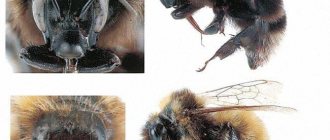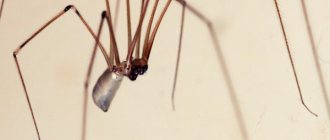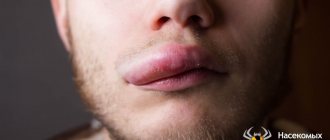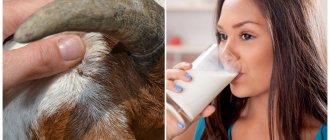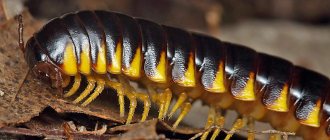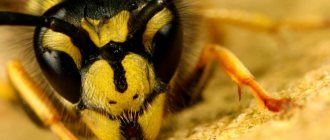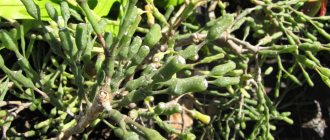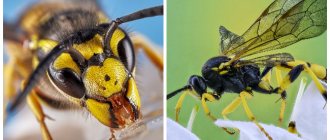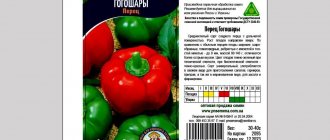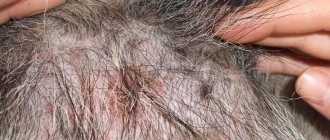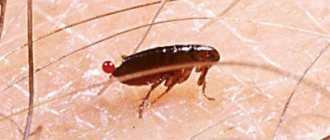Lifestyle
Ammophila has been studied more and better than other relatives. Leads a solitary lifestyle, does not build multi-tiered nests, and does not form a wasp society of working individuals. Each female is sexually mature and lives separately from the others. Insects do not communicate with signs, do not convey warnings to each other. In behavior, the burrowing ammophila wasp is calmer, reproduces its offspring slowly, and begins to lay eggs not with the onset of spring, but in the summer.
The mission of the adult is to search for a potential victim in order to lay an egg in it. Each species chooses a specific type of prey; ammophila preys on cutworm larvae. Finds them underground, paralyzes them into a nerve node, immobilizes them. It drags it into a hole that the female has prepared in advance for the larva. Lays an egg on the body, closes the entrance, and covers it with earth.
After 3-4 days, a larva crawls out of the egg and gradually begins to eat the victim. After 14 days it completes its development cycle and pupates. It spends the winter in this position. In spring, the imago emerges from the cocoon and crawls out. Mating occurs, after which the female begins to hunt for cutworms and lay eggs. Only one generation develops per year.
On a note!
The burrowing wasp is widespread; about 10 species live in Russia. It is found in forests, fields, orchards, vegetable gardens, and summer cottages. Unique species - bee wolf, Larra amathena, ammophila, sphex.
Habitat
Adults fly where there is an abundance of food, as well as cutworm larvae. The insect avoids clean loose sand because the grains of sand quickly fill the newly dug hole. It must remain clean until the victim is thrown there.
The burrowing ammophila wasp loves light soil that is convenient for digging. It contains impurities of clay and lime. Favorite places for insects are forest paths with sparse grass, sunny slopes, and forest edges.
The burrowing wasp's burrows are vertical and resemble a well in appearance. Width up to 2 cm, depth about 5. At the bottom there is a single cell for the larva in the form of a small expansion. The wasp takes out pebbles and large lumps outside and places them near the nest. The insect likes to dig a hole slowly. If you need to dig several nests in advance, you will have to work all day.
Burrowing wasp ammophila
Interesting!
The whole digging process is simple and does not take much time. The jaws play the role of a shovel, the paws - a rake. Finally, he finds a pebble to cover the entrance. After a successful hunt, the next day it will bring there a larva that is several times its size.
Nesting site
As a rule, burrowing wasps (photos of some of them can be seen in this article) nest where it is safe. They dig holes for themselves in the sand, soil, and nest in the bark of trees or the stems of large plants. They do all this, following instinct, for future offspring. At the end of spring, burrowing bees begin their mating season, after which the insects lay eggs in a prepared nest.
Nest building process
The house for the offspring consists of elongated cells 3 cm long. Each of them is built and then filled with prey. Only then does the wasp begin building the next cell. Construction takes 1-2 days. The female has to make 12-15 flights to bring the required amount of dirt. After all the cells have been constructed, the nest is covered with an additional layer of dirt.
Spiders are placed in a special way; large and hard specimens are placed closer to the exit. The larva will have time to grow and get stronger before it gets to them. The wasp carries its prey through the air. She drags the first spider, backing away. An egg is laid on it. The rest of the pelopei are pushed into the hole. Over the course of a year, several generations can change. Summer offspring will grow in 30-40 days.
Information. The common pelopei does not show aggression towards humans. The insect is useful by catching spiders and other pests.
Main distinguishing feature
The life of a wasp depends on whether it is a social or solitary individual. Already from the name it becomes clear that the former live in families, and the latter – separately. This division exists in all numerous insect species. Each single individual has the opportunity to reproduce. In the family, only the uterus continues the family line.
Solitary wasps prefer not to live in large groups. They mate and then lead a solitary life. Paper single females build their nest. In each cell, in addition to the laid egg, the female places a supply of food for the impoverished larva. These are small insects and spiders paralyzed by poison. Having filled the cell, the female seals it.
Diet of burrowing wasps
Adult burrowing wasps feed on plant sap, nectar, and the sweet secretions of certain insects, such as aphids. Some burrowing wasps drink water. And certain species squeeze out the collected nectar from the crops of bees.
Burrowing bees consume nectar and plant sap.
Benefits and harms
Burrowing wasps are mostly beneficial insects. They destroy mole crickets and other burrowing pests, which they use to feed the larvae.
And the bee wolf causes harm . Beekeepers with large apiaries are forced to constantly fight the invasion of such insects, which are the main pests of their honey bees.
Reproduction of burrowing wasps
All burrowing wasps show care towards their offspring. Adults build nests for the new generation, and prepare food for the larvae. The larvae feed on insects, such as caterpillars, spiders, butterflies, flies, and the like.
Each type of burrowing wasp selects certain insects as victims. They show amazing skill in hunting - they deliver fatal blows with precision. When the sting is pricked, the prey is paralyzed and does not deteriorate for a long time. Burrowing wasps paralyze their prey with their poisonous sting.
Burrowing wasps are solitary insects; they do not depend on other individuals, but take care of their offspring independently. When the female digs a hole and fills it with supplies, she lays an egg in it. She closes the hole with a plug made of substrate.
Some species exhibit even more complex behavior. Females check the nest daily and replenish it with fresh prey as the larvae consume the supplies. One female can monitor several nests at the same time.
There are quite a large number of species of burrowing wasps. Let's look at the most famous ones.
Description of the insect
Appearance
The size of burrowing wasps can vary: body length varies among different species from 2 to 55 mm.
At the top, the posterior edge of the pronotum forms a ridge, which is a distinctive feature of this particular group of wasps. And on the sides there are noticeable protrusions - these are humeral tubercles that do not reach the tegulae. From the name it becomes clear that most species of wasps in this group dig burrows in sand or soil, but there are also those that prefer to settle in wood, and representatives of small species - inside plant stems.
A burrowing wasp can be recognized by the presence on its front legs of a number of hard bristles, which look like a ridge and serve as a kind of shovel for the wasp to throw away the soil. Every female and some males have this crest.
The apical segment in most species of burrowing wasps is a wide flat area, with the help of which the wasp pushes out the soil and smoothes the walls of the dug passage.
What do they eat?
Adult burrowing wasps feed on flower nectar, plant juices, and the sweet secretions of insects such as aphids. Sometimes they drink water. Some species of wasps squeeze the nectar they collect from the bees' crops.
Features of reproduction
Burrowing wasps are characterized by caring for their offspring. It consists of building a nest and preparing food for the larvae, for which wasps most often prefer insects that live in open areas. These can be spiders, flies, caterpillars, aphids, butterflies and others. All burrowing wasps are predators, and each species chooses a specific insect as its prey.
At the same time, it is amazing how skillful wasps are in hunting and with what accuracy they deliver decisive blows. The wasp's prey is paralyzed by injecting its sting into the nerve ganglion, so the insect remains fresh for a long time.
This group of wasps are loners , meaning they build nests and care for their young independently of other individuals. Having dug a separate hole in the nest and filled it with provisions, the wasp lays an egg and seals the entrance with a plug, which it makes from the surrounding substrate. At the end of the work, the entrance to the nest is also closed.
Some species of burrowing wasps exhibit more complex behavior. They check the nests every morning and bring back prey as the larvae eat it. Wasps are capable of caring for several nests.
Sandy ammophila
These wasps have slender black bodies with bright red bellies. These are quite large wasps - they can reach 4 centimeters in length.
Sandy ammophila is one of the largest representatives of the family.
Sandy ammophila feeds its larvae with cutworm caterpillars living in the ground. The wasp finds the victim, drives it to the surface of the earth, paralyzes it and drags it to its burrow, and the victim is several times heavier than the wasp. The female drags the moth caterpillar into the nest, lays an egg on it, and then closes the hole and masks the entrance to it.
Allergy symptoms
So, statistics say that about 2% of the world's population suffer from an increased reaction to wasp venom. These people are at risk: there is a high probability of suffocation from a bite in the absence of timely assistance.
What to do if bitten by a wasp?
An allergic reaction can be distinguished by the following symptoms:
- very sharp pain immediately after the bite;
- after a few minutes, severe itching and swelling begins (in some cases, hardening of the wound);
- headaches, shortness of breath, urticaria develops;
- clouding of consciousness, fainting.
Anaphylactic shock may occur - this is the most dangerous degree of an allergic reaction. The following symptoms will indicate its occurrence:
- severe itching on various parts of the body;
- breathing becomes difficult;
- voice disappears;
- drop in blood pressure;
- development of severe heart failure;
- vomit;
- Quincke's edema and asphyxia.
A wasp sting on the neck and other parts of the body in most cases does not pose a serious threat to health and only leaves pain. Only children and people with allergic reactions are at increased risk. Such people must be given help to avoid serious consequences.
How to protect yourself from wasps?
If the situation gets out of control, then it is necessary to urgently call an ambulance to provide professional medical assistance.
It is important to monitor children and their condition before arriving at the hospital
Philanthus - bee wolf
Philanthus is one of the types of burrowing wasps. It is a rather large and strong insect, measuring from 12 to 15 mm. Has a too large head compared to the body and strong jaws. The chest of the philanthus is black, the abdomen is bright yellow, and there are from one to three white stripes on the back. They called him the bee wolf because he attacks honey bees.
This happens as follows. The philanthus rushes at the bee when it, unsuspectingly, collects pollen from a flower. Having grabbed it with its paws, the bee wolf stings the victim in the neck and kills. Rhythmically moving his paws, he squeezes out the nectar collected by the bee from the bee's crop, which he licks with his tongue. Then the bee carries the completely empty bee back to her burrow to use it as food for her offspring.
Philanthus can cause serious harm to beekeepers if it settles next to the hives, since the bees stop flying out for honey and sit in the hives. The queen bee stops laying eggs and the colony gradually weakens. Paper wasps differ in the way they build their nests.
The road wasp lays larvae in the body of the spider. Read about the peculiarities of life and behavior of this wasp species here.
Are you already tormented by wasps that won’t let you live in peace? Find out how to make a trap for these insects using this link https://stopvreditel.ru/doma/sredstva/lovushka-dlja-os.html.
Appearance
The burrowing wasp is a slender, thin-bodied insect. There is no external resemblance to ordinary social wasps. Most often, their body color is black. The head is small, lowered down. When examining it, the jaws and straight long antennae are clearly visualized.
The chest is connected to the abdomen by a thin elongated segment. The wasp's abdomen is fusiform or barrel-shaped, but flattened. Its color is bright red or orange. The limbs are long and end in a special comb. This is what distinguishes the burrowing wasp from the paper wasp.
Wasps of this genus have thin transparent wings, but they are used extremely rarely. The size of the female burrowing insect is 25-38 mm. Male burrowers are usually much smaller.
Is it dangerous for humans?
Burrowing wasps are less poisonous and dangerous when compared to paper wasps. Ammophila bites people extremely rarely. This happens most often in cases of urgent need. Usually these insects prefer to hide unnoticed from human eyes. Ammophila does not transmit signs to other relatives, so there is no risk of an attack by a whole swarm.
She uses the sting for the purpose of self-defense when she is accidentally pressed on , stepped on or pressed against her. The ammophila will not be the first to attack or bite. The burrowing wasp does not form cocoon-shaped nests, so it has nothing to protect. And if a person accidentally steps on the place where the larva with the victim is hidden, then he will not be able to damage it, since it is located at a great depth.
After a bite, a standard allergic reaction develops.
It usually goes away on its own after first aid is provided to the victim.:
- Inspect the wound to identify the sting remaining in it. Usually it does not remain in the wound, because, unlike bees, it is firmly attached to the abdomen and there are no notches on it. It can remain on the victim only if the burrowing wasp was killed during the bite. If a sting is found, it is carefully removed.
- The wound is washed with any antiseptic (hydrogen peroxide, potassium permanganate solution, chlorhexidine solution). After treatment, apply an ice compress to the bitten area. This manipulation allows you to slow down the absorption of the toxic substance. Some try to squeeze out the poison, but this should absolutely not be done. Due to such actions, an infection can be introduced, which will provoke the development of an inflammatory reaction.
- If a person has been stung in nature and there are no disinfectants at hand, then you can use a plantain leaf. It is pre-washed with water, kneaded and applied to the wound. Dandelion leaf is also suitable for these purposes.
- The stung person is provided with complete peace of mind and is also given plenty of fluids to drink. Water or warm sweet tea will do.
- It is advisable to take antihistamines (Cetrin, Loratadine, Suprastin), which will prevent the development of an allergic reaction. You can also apply an ointment with antihistamine components locally.
The listed actions are appropriate if the bite is single. If the insects have made multiple bites, as well as if the neck, tongue or larynx are injured, then you should immediately call an ambulance. The same should be done if a wasp has bitten a baby. Children are at increased risk of developing a serious allergic reaction due to a weak immune system.
Most often, the burrowing wasp does not pose a danger to humans and is also useful for gardeners. This is a special species of Hymenoptera that occupies a special place in the ecosystem.
If a wasp bites
As statistics show, the peak of wasp stings occurs in the summer months of July and August, when there are many flowers everywhere, as well as a large number of ripe sweet fruits and berries.
Literature
- Kazenas V. L. Burrowing wasps of Central Asia and Kazakhstan.
Determinant . // Science, , 170 pp. - Kazenas V.L. Burrowing wasps (Hymenoptera, Sphecidae) of Southeast Kazakhstan
// Tr. VEO, 1972, pp. 93-533. - Kazenas V. L.
Fauna and biology of burrowing wasps (Hymenoptera, Sphecidae) of Kazakhstan and Central Asia. - Almaty: KazgosINTI, 2001. - 334 p. — ISBN 9965-466-31-9. - Nemkov P. G., Kazenas V. L., Budris E. R., Antropov A. V. 1995. Sem.
Sphecidae - Burrowing wasps // Key to insects of the Russian Far East. T. IV. Reticuloptera, Scorpioptera, Hymenoptera. Part 1 / under general ed. P. A. Lera. - St. Petersburg: Nauka, 1995. - pp. 368–480. — 606 p. — 3150 copies. — ISBN 5-02-025944-6. - Pulavsky V.V. 1978. Sem.
Sphecidae - Burrowing wasps // Key to insects of the European part of the USSR. T. III. Hymenoptera. First part // Suborder Apocrita - Stalk-bellied (Arnoldi K.V. et al.) / under the general. ed. G. S. Medvedeva. - L.: Nauka, 1978. - P. 173-279. — 584 p. — (Key guides to the fauna of the USSR, published by the Zoological Institute of the USSR Academy of Sciences; issue 119). — 3500 copies.
- Bitsch J., Y. Barbier, S. F. Gayubo, K. Schmidt & M. Ohl (1997) Hyménoptères Sphecidae d´Europe occidentale
. Vol. 2. 1-429, Paris. - Blösch, M. (2000) Die Grabwespen Deutschlands
. 1-480, Goecke & Evers, Keltern. - Lomholdt, O. (1984) The Sphecidae (Hymenoptera) of Fennoscandia and Denmark.
Fauna Ent.Scan. 4, part 1: 1-224.
Nest construction
The selection of a place to build a nest is made by the queen of the earth wasp. In the spring, the first thing she does is go in search of a site where she will give birth to a new swarm. She may be attracted by an empty, spacious hole and an abundance of food nearby. The queen builds the first honeycomb from tree bark, chewed and moistened with saliva. After hardening, the mass becomes like rough paper. Initially, 5-10 cells are made, into which an egg is laid. After 35-40, the first assistants will appear. The following tiers and cells will be attached to the nest.
At the end of summer, the dwelling reaches its maximum size. From the eggs laid by the uterus, females capable of procreation and males appear. In August-September they begin to mate. The old queen leaves the house and flies away, young fertilized females hide in the ground or crevices of trees. Only they will survive the winter. The remaining inhabitants will freeze and die.
Attention. There is no need to fear that ground wasps will return to their old nest next year. Overwintered queens will give birth to a new colony in another location.
Striped predators
At first glance, it is not clear why wasps are useful? Their main purpose, like any predator, is to maintain natural balance. The queen and worker wasps tirelessly hunt for various insects. Their remains are chewed, mixed with enzymes and used to feed wasp larvae. Among the most productive pest fighters in the garden are Scolia and Typhia. These families help get rid of the main enemy of plants - beetleworm. The larvae of the cockchafer are polyphagous; they eat the roots of any plant. The wasp offspring parasitize the pest larvae, eating it alive.
Scolia are primitive solitary wasps that help exterminate the larvae of lamellar beetles. The sizes of insects are from 10 to 100 mm, the wingspan is 60-100 mm. The body color is black, with bright yellow or red spots on the abdomen. Membranous wings with a purple sheen. Females lay eggs on the larva of the beetle, bronze beetle, and rhinoceros beetle. Scolia does not kill the victim, but immobilizes it. The larva that emerges from the egg begins to feed from the least important organs. This natural instinct helps keep food fresh for a long time.
Scolia's closest relative is Typhia. It is smaller in size (5-12 mm), the body is uniformly colored black. The female lays eggs on the larvae of pests - bread beetles. Thick-legged typhias live in Russia. This species has red-brown limbs. The entire body is covered with white hairs. Females dig a tunnel to a depth of 10 cm to paralyze the June beetle and lay an egg. After a few hours, the beetle larva is able to move, but its existence will not last long.
Striped paper wasps catch pests not in the ground, but on the surface and in the air. Their favorite prey is flies. They do not avoid caterpillars, bugs, leaf rollers, mosquitoes, or aphids.
Characteristics of the hornet
As a description of the wasp, it should be noted that the insect has a length of 3-5.5 cm. The wingspan will correspond to 5 cm. The female is larger in size than the male. Apart from their size, they are distinguished from ordinary wasps by the presence of 2 round spots of a bright yellow hue on the 2nd and 3rd abdominal segments. A similar spot, but smaller in size, is located on the scutellum. Other parts of the body are covered with red hairs.
The largest representative of social wasps from the order Hymenoptera, distributed in the northern hemisphere. The insect has a wasp-like waist and transparent wings. The abdomen is striped, the eyes are large, and the mouthparts are equipped with strong jaws. The largest wasp in the world differs from its smaller relatives by a richer range of colors: black, brown, orange and yellow colors are present on the body of this bright predator.
These insects create colonies and build dwellings consisting of honeycombs, which are arranged horizontally in several rows (up to 7 tiers). The material for building the nest is wood, which is exposed to saliva during the process of thorough chewing. These wasps choose places to live in the hollows of large trees, in attics and under the roof. In steppe regions, hornets prefer to build homes in the burrows of forest animals.
The hornet can feed on both plant foods and various insects. Among vegetarian foods, he prefers flower nectar, as well as ripe sweet fruits, honey and berries. However, it is a predator that feeds its larvae with prey. Among its victims are flies, gadflies, horseflies, wasps, locusts, and bees. The hornet thoroughly chews its prey and then feeds it with the resulting mass of its larvae.
Worker hornets bring food for the next batch of larvae and for the queen, protect the nest from potential enemies and continue to build it. The queen is now exclusively occupied with laying eggs. In the autumn, young queens and drones also grow up in the aspen family. After mating at the end of autumn, they hide for the winter, and the old queen dies.
What kind of drug is Regent?
Initially, Regent 800 was used to treat cultivated plants against garden pests. It was later noticed that the substance also has a detrimental effect on cockroaches.
Composition of the drug Regent
The main active ingredient of the insecticide is fipronil, a pesticide belonging to the second class of poisons. It is included in the composition in a ratio of 800 g per 1 kg of the drug and is characterized by long-term toxicity. Additionally, the poison contains permethrin (10%) and chlorophos (15%), which are converted in the intestines of the pest under the influence of stomach acid into very toxic substances.
Release form
Regent is available in the form of:
- powder (0.5 g bags or 100 g plastic jars);
- emulsions (in 5 mg ampoules or 100 ml bottles).
To disinfect a room from pests, poison in any form requires dissolution in water.
Breeding
Beekeeping is considered an interesting, useful and profitable activity, which is also actively encouraged in many countries. The fact is that in nature there is a constant decline in the number of these insects, which can negatively affect agriculture.
Wooden bee hives
For a novice beekeeper, breeding begins with setting up an apiary in the right place, purchasing a sufficient number of hives, and also purchasing several bee families. To engage in this business on a serious scale, you need to have about 50 families.
There is a huge variety of honey bee breeds, and new ones appear periodically thanks to the selection work of experienced beekeepers. In general, it is worth noting that this is not an easy task, since many factors, both dependent on the beekeeper and random, can have a bad effect on the quality and quantity of honey.
Frames on which bees build honeycombs Interesting fact: experienced beekeepers use smoke to calm insects. This method allows you to quickly inspect the hive. Sensing smoke, the bees consider it a sign of a fire and rush to save the honey. At the same time, they fill the abdomen so much that they cannot sting for some time.
When should you go to the hospital?
There are several cases in which you should immediately call an ambulance or go to the hospital yourself:
1. Severe inflammation began at the site of the bite;
2. The victim suffers from the following diseases:
- Asthma - first, stop the asthma attack with a special inhaler;
- For allergies of any kind - give an antihistamine;
- Heart problems - stimulate cardiac activity with valocordin, nitrospray or nitroglycerin;
3. The wasp stung a child or a pregnant woman;
4. There are several wounds on the body (for adults – more than 5, for children – more than 1);
5. The bite site is located on the face or neck;
6. The victim went into anaphylactic shock.
Use of poison in medicine
It is known that bee stings are used in medicine for certain diseases, but with wasp stings the situation is more complicated. To date, there is no data on the widespread use of wasp venom in medicine for the reason that it is very difficult to obtain. However, experimental development is still underway, but so far in small quantities.
For example, there is an opinion that wasp venom kills cancer cells, and in Spain and some other countries, based on some components of this poison, they are trying to create a cure for cancer tumors, and the results are supposedly encouraging. But this invention has not yet been officially confirmed or patented. The research used venom from the Brazilian wasp Polybia paulista, and the results were promising: the venom affected some cancer cells and did not kill healthy cells. But the research has not yet been completed and the finished drug has not yet been released.
Wasps are able to distinguish between their relatives. This feature is inherent only in social species of wasps, which have their own hierarchy. Solitary wasps cannot do this.
The production of vaccines based on wasp venom for those who suffer from allergic reactions to the bites of these insects is not yet so widespread. The vaccine contains low amounts of histamine and toxins. At the same time, a certain amount of substances is retained by which the immune system “recognizes” the allergens contained in the poison. This vaccination is done before the activity of these insects begins, and the reaction to the bite will no longer be so strong. But, unfortunately, this is also not very common yet.
Danger to people
Being close to predatory insects can be beneficial. Wasps that have settled on the site will help with the destruction of pests. Over the summer they will catch hundreds of flies, caterpillars, and butterflies for their offspring. All the positives are outweighed by the harm done in a few cases. Why are ground wasps dangerous?
- If there are allergy sufferers in the family, a bite can provoke a dangerous immune reaction in the body.
- The proximity of insects is undesirable for small children.
- The nest is located in the garden bed and interferes with harvesting.
- The proximity of wasps next to the apiary is unacceptable. Predators will kill bees.
Attention. Wasp venom can paralyze or kill invertebrates. The bite causes significant pain to humans and domestic animals. The danger threatens only people with individual intolerance to insect toxins.
